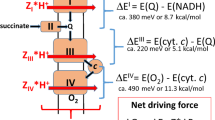Abstract
We have shown that the Metabolic Control Analysis (MCA) can explain the threshold effect observed in the expression of mitochondrial diseases [8]. As a matter of fact, the effect of a specific inhibitor on the flux of O2 consumption mimics a defect in a step of oxidative phosphorylation. The observed threshold is correlated to the value of the control coefficient of the inhibited step.
For this reason, we have studied the repartition of the control coefficients of different steps in oxidative phosphorylation on various tissues (liver, kidney, brain, skeletal muscle and heart). We discuss the results in terms of metabolic control theory and provide a possible explanation for the heterogeneous phenotype of those pathologies. We present the double threshold hypothesis of both a threshold in the energy demand of a tissue and in the energy supply by oxidative phosphorylation. (Mol Cell Biochem 174: 143–148, 1997)
Similar content being viewed by others
References
Chomin A, Martinuzzi A, Yoneda M, Daga A, Hurko O, Johns D, Lai ST, Nonaka I, Angelini C, Attardi G: Melas mutation in mtDNA binding site for transcription termination factor causes defects in protein synthesis and in respiration but no change in levels of upstream and downstream mature transcripts. Proc Natl Acad Sci USA 89: 4221– 4225, 1992
Sciacco M, Bonilla E, Schon EA, DiMauro S, Moraes CT: Distribution of wild-type and common deletion forms of mtDNA in normal and respiration-deficient muscle fibers from patients with mitochondrial myopathy. Human Mol Gen 3: 13–19, 1992
Morgan-Hughes JA, Hayes D, Clark JB, Landon DN, Swash M, Strak RJ, Rudge P: Mitochondrial encephalomyopathies. Biochemical studies in two cases revealing defects in the respiratory chain. Brain 105: 553– 582, 1982
Chance B, Williams GR: The respiratory chain and oxidative phosphorylation. In: RA Alberty (ed). Adv Enzymol 17, 1956 pp 65– 134
Wharton DC, Tzagoloff A: Cytochrome-c-oxidase from beef heart mitochondria. In: RW Estabrook, ME Pullman (eds). Meth Enzymol X, 1967 pp. 245–250
Gellerich FN, Kunz WS, Bohnensack R: Estimation of flux control coefficients from inhibitor titrations by non-linear regression. FEBS Lett 274: 167–170, 1990
Holzhütter H, Colosimo A: SIMFIT: a microcomputer software-toolkit for modelistic studies in biochemistry. CABIOS 6: 23–28, 1990
Letellier T, Heinrich R, Malgat M, Mazat J-P: The kinetic basis of threshold effects observed in mitochondrial diseases. A systemic approach. Biochim J 302: 171–174, 1994
Malgat M, Letellier T, Jouaville SL, Mazat J-P: Value of the control theory in the study of cellular metabolism – Biomedical implications. J Biol Syst 3: 165–175, 1995
Heinrich R, Rapoport TA: A linear steady-state treatment of enzymatic chains. General properties, control and effector strength. Eur J Biochem 42: 89–95, 1974
Kacser H, Burns JA: The control of flux. In: DD Davies (ed). Rate Control of Biological Processes, (Cambridge University Press, Cambridge UK 1973) pp 65–104
Bindoff LA: Thesis, Newcastle upon Tyne University, 1990
Kuznetsov AV, Clark J F, Winkler K, Kunz WS: Change in flux control coefficient of cytochrome c oxidase in copper deficient mottled brindled mice. In: E Gnaiger, FN Gellerich, M Wyss (eds). What is Controlling Life? Modern Trends in BioThermokinetics Vol 3, University Press, Innsbruck 1994 pp 141–144
Korzeniewsky B, Mazat J-P: Theoretical studies on the control of oxidative phosphorylation in muscle mitochondria. Application to mitochondrial deficiencies. Biochem J 319: 143–148, 1996
Beziat F, Volz-Lingenhol A, Saint Paul N, Alziari S: Mitochondrial genome expression in a mutant strain of D. subobscura, an animal model for large scale mtDNA deletion. Nucl Acid Res 21: 387–392, 1993
Debise R, Touraille S, Durand R, Alziari S: Biochemical consequences of a large deletion in the mitochondrial genome of a drosophila subobscura strain. Biochem Biophys Res Commun 196: 355–362, 1993
Spelbrink JN, Van Oost BA, Van den Bogert C: The relationship between mitochondrial genotype and mitochondrial phenotype in lymphoblasts with a heteroplasmic mtDNA deletion. Human Mol Gen 3: 1989–1997, 1994
Wallace DC: Diseases of the mitochondrial DNA. Ann Rev Biochem 6l: 1175–1212, 1992
Wallace DC: Mitochondrial genetics: A paradigm for aging and degenerative diseases? Science 256: 128–133, 1993
Kacser H, Burns JA: The molecular basis of dominance: Genetics 97: 630–666, 1981
Author information
Authors and Affiliations
Rights and permissions
About this article
Cite this article
Letellier, T., Bédes, F., Malgat, M. et al. Metabolic control analysis and threshold effect in oxidative phosphorylation: Implications for mitochondrial pathologies. Mol Cell Biochem 174, 143–148 (1997). https://doi.org/10.1023/A:1006875517267
Issue Date:
DOI: https://doi.org/10.1023/A:1006875517267




